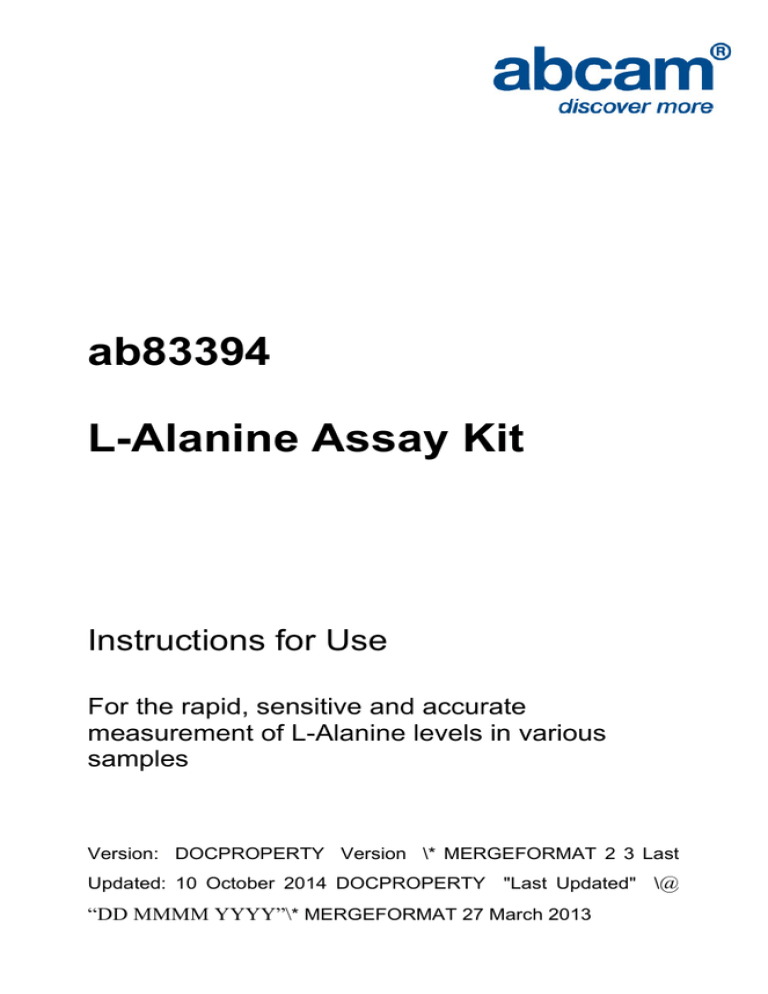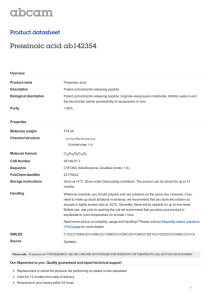
ab83394
L-Alanine Assay Kit
Instructions for Use
For the rapid, sensitive and accurate
measurement of L-Alanine levels in various
samples
Version: DOCPROPERTY Version \* MERGEFORMAT 2 3 Last
Updated: 10 October 2014 DOCPROPERTY "Last Updated" \@
“DD MMMM YYYY”\* MERGEFORMAT 27 March 2013
This product is for research use only and is not
intended for diagnostic use.
1
Table of Contents
1.
Overview
3
2.
Protocol Summary
4
3.
Components and Storage
5
4.
Assay Protocol
7
5.
Data Analysis
9
6.
Troubleshooting
11
2
1. Overview
Alanine is the 2nd most abundant of the 20 proteinogenic amino
acids. Nonessential, being available from dietary sources, it plays a
key role in the glucose-alanine cycle between tissues and liver. In
muscle and other tissues that degrade amino acids, amino groups
are pooled as glutamate by transamination. Glutamate then transfers
the amino group to pyruvate via alanine aminotransferase, forming
alanine and α-ketoglutarate. The alanine is passed into the blood
and
transported
to
the
liver.
A
reverse
of
the
alanine
aminotransferase reaction takes place in liver. Pyruvate can be used
in gluconeogenesis, to form glucose which may return to other
tissues through the circulatory system. There appears to be a
correlation between alanine levels and and higher blood pressure,
energy intake, cholesterol levels, and body mass index.
Abcam’s L-Alanine Assay Kit provides a sensitive detection method
of L-alanine. In the kit, alanine is converted to pyruvate which is
specifically
(λ=570nm:
detected
leading
to
proportional
color
0-10 nmol) or fluorescence (Ex/Em 535/587nm: 0-
1 nmol) development. Serum concentration: ~24-76 µg/ml mL (~3-9
nmol/10 µlµL).
3
2. Protocol Summary
Sample Preparation
Standard Curve Preparation
Prepare and Add Reaction Mix
Measure Optical Density or Fluorescence
4
3. Components and Storage
A. Kit Components
Item
Quantity
Alanine Assay Buffer
25 mL
Alanine Probe (DMSO)
0.2 mL
Alanine Converting Enzyme (Lyophilized)
1 vial
Alanine Development Mix (Lyophilized)
1 vial
Alanine Standard (Lyophilized)
1 vial
* Store the kit at -20°C, protect from light. Allow Assay Buffer to
warm to room temperature before use. Briefly centrifuge vials before
opening. Read the entire protocol before performing the assay.
PROBE: Ready to use as supplied. Allow to warm to room
temperature to thaw the DMSO solution before use. Store at -20°C,
protect from light and moisture. Use within two months.
ALANINE CONVERTING ENZYME, DEVELOPMENT ENZYME
MIX: Dissolve separately with 220 μl μL Assay Buffer. Pipette up and
down to dissolve. Aliquot into portions and store at -20°C. Avoid
5
repeated freeze/thaw cycles. Use within two months. Keep the
Alanine Enzyme Mix on ice during the assay and protect from light.
ALANINE STANDARD: Dissolve in 100 μl μL dH2O to generate 100
mM (100 nmol/μLμl) Alanine Standard solution. Keep cold while in
use. Store at -20°C.
B. Additional Materials Required
Microcentrifuge
Pipettes and pipette tips
Fluorescent or colorimetric microplate reader
96 well plate
Orbital shaker
6
4. Assay Protocol
1. Sample Preparation:
Tissues or cells (1×106) can be homogenized in 100 μl μL Assay
Buffer centrifuge to remove insoluble material at 13,000 g, 10
minutes.
10-50 μLμl deproteinized serum samples can be directly diluted in
the Assay Buffer. Bring sample wells to 50 μLμl/well with Assay
Buffer in a
96-well plate.
For unknown samples, we suggest testing several doses to make
sure the readings are within the standard curve linear range.
We recommend (per well):
5-50 uL of cell culture medium
Lysates from 2.5x10e5 cells
0.02-0.1 mg extracted protein from tissue
2. Standard Curve Preparation:
a. For the colorimetric assay:
Dilute 10 μl of the 100mM Alanine standard with 990 μLμl DI H2O
to generate 1 mM standard Alanine. Add 0, 2, 4, 6, 8, 10 μL μl of
the diluted Alanine standard into a 96-well plate to generate 0, 2,
7
4, 6, 8, 10 nmol/well standard. Bring the volume to 50 μL μl with
Assay Buffer.
b. For the fluorometric assay:
Dilute the L-Alanine Standard solution to 0.1 nmol/ μL μl by
adding 10 μL μl of the L-Alanine Standard to 990 μL μl of LAlanine Assay Buffer and mix well. Then take 20 μL μl into 180
μL μl of L-Alanine Assay Buffer and mix well.
Add 0, 2, 4, 6, 8, 10 μL μl into a series of wells of a 96 well plate.
Adjust volume to 50 μLμl/well with L-Alanine Assay Buffer to
generate 0, 0.2, 0.4, 0.6, 0.8, 1.0 nmol/well of the L-Alanine
Standard.
3. Reaction Mix: Mix enough reagent for the number of assays to be
performed. For each well, prepare a total 50 μL μl Reaction Mix
containing the following components:
Alanine Measurement
Bkgd Control*
Assay Buffer
44 μL μl
46 μLμl
Alanine Converting Enzyme
2 μLμl
---
Alanine Development Mix
2 μLμl
2 μL μl
Alanine Probe**
2 μLμl
2 μLμl
Add 50 μl μL of the Reaction Mix to each well containing Alanine
standard, test and background control samples. Mix well. Incubate
the reaction for 60 min at 37°C, protect from light.
8
*Note: Use background control if high levels of pyruvate are
suspected to be in the samples.
**Note: For the fluorescent assay dilute the probe 5-10X to reduce
background.
4. Measure OD at 570 nm in a microplate reader or fluorescence
using Ex/Em 535/587 nm.
5. Data Analysis
Correct background by subtracting the value derived from the zero
Alanine control from all sample readings. The background reading
can be significant and must be subtracted from sample readings.
Plot the Alanine standard Curve.
Alanine concentrations of the test samples can then be calculated:
Concentration = Sa / Sv (nmol/μl or mM)
Where:
Sa is the sample amount of unknown (in nmol) from standard curve,
Sv is sample volume (μLμl) added into the wells.
L-Alanine Molecular Weight is 89.1 g/mol.
9
10
11
6. Troubleshooting
Problem
Reason
Solution
Assay not
working
Assay buffer at
wrong temperature
Assay buffer must not be chilled
- needs to be at RT
Protocol step missed
Plate read at
incorrect wavelength
Unsuitable microtiter
plate for assay
Unexpected
results
Re-read and follow the protocol
exactly
Ensure you are using
appropriate reader and filter
settings (refer to datasheet)
Fluorescence: Black plates
(clear bottoms);
Luminescence: White plates;
Colorimetry: Clear plates.
If critical, datasheet will indicate
whether to use flat- or U-shaped
wells
Measured at wrong
wavelength
Use appropriate reader and filter
settings described in datasheet
Samples contain
impeding substances
Unsuitable sample
type
Troubleshoot and also consider
deproteinizing samples
Use recommended samples
types as listed on the datasheet
Sample readings are
outside linear range
Concentrate/ dilute samples to
be in linear range
12
Samples
with
inconsistent
readings
Unsuitable sample
type
Samples prepared in
the wrong buffer
Samples not
deproteinized (if
indicated on
datasheet)
Cell/ tissue samples
not sufficiently
homogenized
Too many freezethaw cycles
Samples contain
impeding substances
Samples are too old
or incorrectly stored
Lower/
Higher
readings in
samples
and
standards
Not fully thawed kit
components
Out-of-date kit or
incorrectly stored
reagents
Reagents sitting for
extended periods on
ice
Incorrect incubation
time/ temperature
Incorrect amounts
used
Refer to datasheet for details
about incompatible samples
Use the assay buffer provided
(or refer to datasheet for
instructions)
Use the 10kDa spin column
(ab93349)
Increase sonication time/
number of strokes with the
Dounce homogenizer
Aliquot samples to reduce the
number of freeze-thaw cycles
Troubleshoot and also consider
deproteinizing samples
Use freshly made samples and
store at recommended
temperature until use
Wait for components to thaw
completely and gently mix prior
use
Always check expiry date and
store kit components as
recommended on the datasheet
Try to prepare a fresh reaction
mix prior to each use
Refer to datasheet for
recommended incubation time
and/ or temperature
Check pipette is calibrated
correctly (always use smallest
volume pipette that can pipette
entire volume)
13
Problem
Reason
Solution
Standard
curve is not
linear
Not fully thawed kit
components
Wait for components to thaw
completely and gently mix prior
use
Pipetting errors when
setting up the
standard curve
Incorrect pipetting
when preparing the
reaction mix
Air bubbles in wells
Concentration of
standard stock
incorrect
Errors in standard
curve calculations
Use of other
reagents than those
provided with the kit
Try not to pipette too small
volumes
Always prepare a master mix
Air bubbles will interfere with
readings; try to avoid producing
air bubbles and always remove
bubbles prior to reading plates
Recheck datasheet for
recommended concentrations of
standard stocks
Refer to datasheet and re-check
the calculations
Use fresh components from the
same kit
For further technical questions please do not hesitate to
contact us by email ( HYPERLINK "mailto:technical@abcam.com"
technical@abcam.com) or phone (select “contact us” on
HYPERLINK "http://www.abcam.com" www.abcam.com for the
phone number for your region).
14
15
UK, EU and ROW
Email: technical@abcam.com | Tel: +44(0)1223-696000
Austria
Email: wissenschaftlicherdienst@abcam.com | Tel: 019-288-259
France
Email: supportscientifique@abcam.com | Tel: 01-46-94-62-96
Germany
Email: wissenschaftlicherdienst@abcam.com | Tel: 030-896-779-154
Spain
Email: soportecientifico@abcam.com | Tel: 911-146-554
Switzerland
Email: technical@abcam.com
Tel (Deutsch): 0435-016-424 | Tel (Français): 0615-000-530
US and Latin America
Email: us.technical@abcam.com | Tel: 888-77-ABCAM (22226)
Canada
Email: ca.technical@abcam.com | Tel: 877-749-8807
China and Asia Pacific
Email: hk.technical@abcam.com | Tel: 108008523689 (中國聯通)
Japan
Email: technical@abcam.co.jp | Tel: +81-(0)3-6231-0940
www.abcam.com | www.abcam.cn | www.abcam.co.jp
16
Copyright © 2014 Abcam, All Rights Reserved. The Abcam logo is a registered trademark.
All information / detail is correct at time of going to print.
UK, EU and ROW
Email: technical@abcam.com
Tel: +44 (0)1223 696000
www.abcam.com
US, Canada and Latin America
Email: us.technical@abcam.com
Tel: 888-77-ABCAM (22226)
www.abcam.com
China and Asia Pacific
Email: hk.technical@abcam.com
Tel: 108008523689 (中國聯通)
www.abcam.cn
Japan
Email: technical@abcam.co.jp
Tel: +81-(0)3-6231-0940
www.abcam.co.jp
Copyright © 2012 Abcam, All Rights Reserved. The Abcam logo is a registered trademark.
All information / detail is correct at time of going to print.
17



